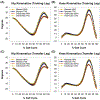Learning and interlimb transfer of new gait patterns are facilitated by distributed practice across days
- PMID: 30831544
- PMCID: PMC6474794
- DOI: 10.1016/j.gaitpost.2019.02.019
Learning and interlimb transfer of new gait patterns are facilitated by distributed practice across days
Abstract
Background: Previous studies have shown that the extent to which learning with one limb transfers to the opposite, untrained limb (i.e., interlimb transfer) is proportional to the amount of prior learning (or skill acquisition) that has occurred in the training limb. Thus, it is likely that distributed practice-a training strategy that is known to facilitate learning-will result in greater interlimb transfer than massed practice.
Research question: To evaluate the effects of massed and distributed practice on acquisition and interlimb transfer of leg motor skills during walking.
Methods: Forty-five subjects learned a new gait pattern that required greater hip and knee flexion during the swing phase of gait. The new gait pattern was displayed as a foot trajectory in the sagittal plane and participants attempted to match their foot trajectory to this template. Subjects in the massed practice group (n = 20) learned the task on a single day, whereas subjects in the distributed practice group (n = 25) learned the task that was spaced over two consecutive days (training phase). Following completion of training, subjects in both groups practiced the task with their untrained, opposite leg to evaluate interlimb transfer (transfer phase).
Results: Results indicated that the amount of skill acquisition (i.e., reductions in tracking error) on the training leg was significantly higher (P < 0.05) in the distributed practice group when compared with the massed practice group. Similarly, the amount of interlimb transfer was also significantly higher (P < 0.05) in the distributed practice group both at the beginning and end of the transfer phase.
Significance: The findings indicate that acquisition and interlimb transfer of leg motor skills are significantly greater when the task was learned using distributed practice, which may have implications for gait rehabilitation in individuals with unilateral deficits, such as stroke.
Keywords: Consolidation; Cross education; Intermanual; Skill learning; Spaced practice; Spacing.
Copyright © 2019 Elsevier B.V. All rights reserved.
Figures





Similar articles
-
Rest the brain to learn new gait patterns after stroke.J Neuroeng Rehabil. 2024 Oct 29;21(1):192. doi: 10.1186/s12984-024-01494-8. J Neuroeng Rehabil. 2024. PMID: 39472911 Free PMC article.
-
Interlimb transfer of motor skill learning during walking: No evidence for asymmetric transfer.Gait Posture. 2017 Jul;56:24-30. doi: 10.1016/j.gaitpost.2017.04.032. Epub 2017 Apr 27. Gait Posture. 2017. PMID: 28482202 Free PMC article. Clinical Trial.
-
Learning new gait patterns: Age-related differences in skill acquisition and interlimb transfer.Exp Gerontol. 2018 Oct 1;111:45-52. doi: 10.1016/j.exger.2018.07.001. Epub 2018 Jul 4. Exp Gerontol. 2018. PMID: 29981399 Free PMC article.
-
Contributions to the understanding of gait control.Dan Med J. 2014 Apr;61(4):B4823. Dan Med J. 2014. PMID: 24814597 Review.
-
Possible mechanism for transfer of motor skill learning: implication of the cerebellum.Cerebellum. 2004;3(4):204-11. doi: 10.1080/14734220410018977. Cerebellum. 2004. PMID: 15686098 Review.
Cited by
-
Functional Resistance Training to Improve Knee Strength and Function After Acute Anterior Cruciate Ligament Reconstruction: A Case Study.Sports Health. 2021 Mar;13(2):136-144. doi: 10.1177/1941738120955184. Epub 2020 Dec 18. Sports Health. 2021. PMID: 33337984 Free PMC article.
-
Rest the brain to learn new gait patterns after stroke.J Neuroeng Rehabil. 2024 Oct 29;21(1):192. doi: 10.1186/s12984-024-01494-8. J Neuroeng Rehabil. 2024. PMID: 39472911 Free PMC article.
-
Effect of conventional transcranial direct current stimulation devices and electrode sizes on motor cortical excitability of the quadriceps muscle.Restor Neurol Neurosci. 2021;39(5):379-391. doi: 10.3233/RNN-211210. Restor Neurol Neurosci. 2021. PMID: 34657855 Free PMC article.
-
Learning Gait Modifications for Musculoskeletal Rehabilitation: Applying Motor Learning Principles to Improve Research and Clinical Implementation.Phys Ther. 2021 Feb 4;101(2):pzaa207. doi: 10.1093/ptj/pzaa207. Phys Ther. 2021. PMID: 33351940 Free PMC article.
References
-
- De Luca A, Giannoni P, Vernetti H, Capra C, Lentino C, Checchia GA, et al. Training the Unimpaired Arm Improves the Motion of the Impaired Arm and the Sitting Balance in Chronic Stroke Survivors. IEEE Trans Neural Syst Rehabil Eng. 2017;25:873–82. - PubMed
Publication types
MeSH terms
Grants and funding
LinkOut - more resources
Full Text Sources

